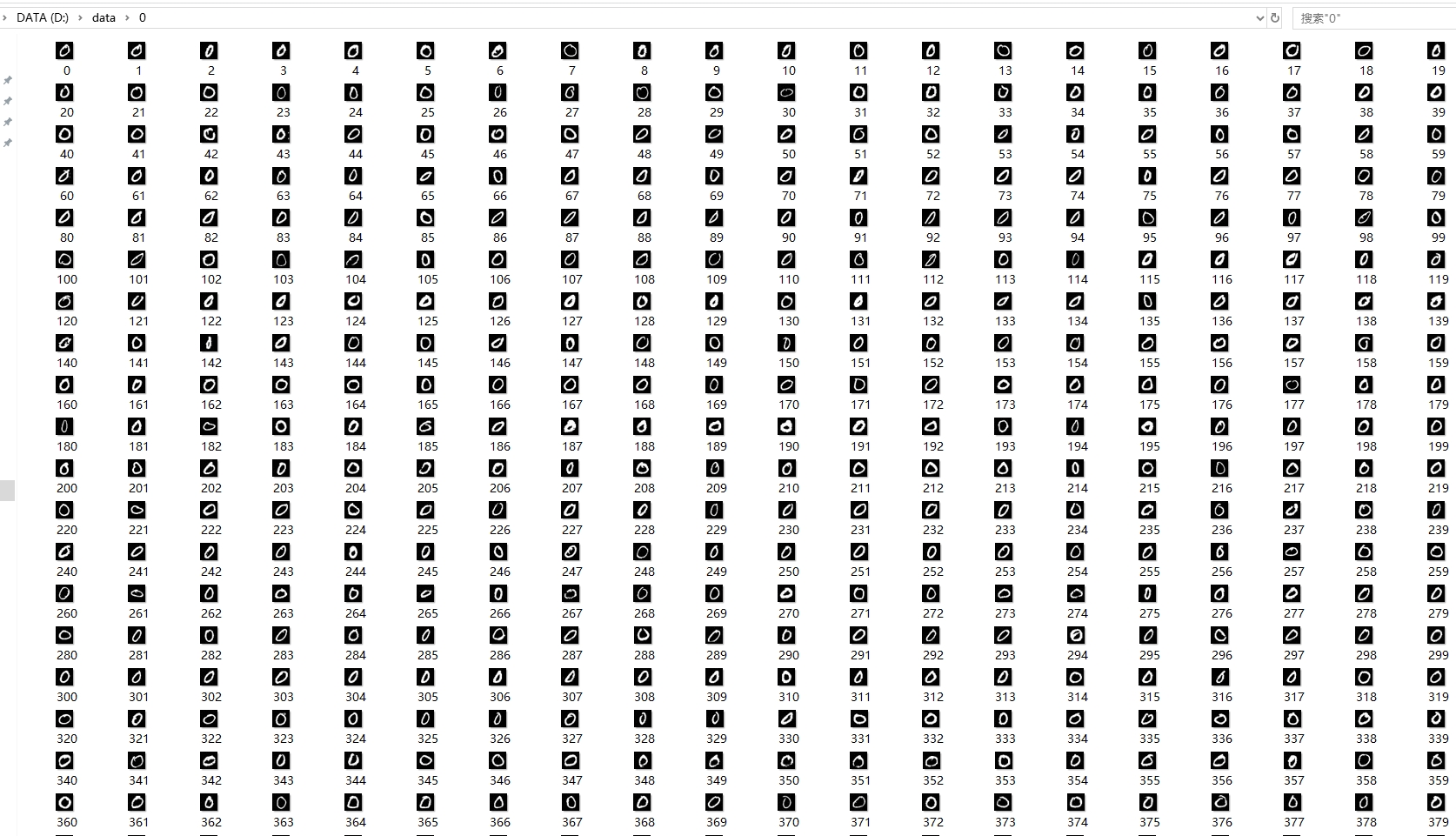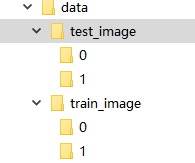简介
学习SVM(一) SVM模型训练与分类的OpenCV实现
学习SVM(二) 如何理解支持向量机的最大分类间隔
学习SVM(三)理解SVM中的对偶问题
学习SVM(四) 理解SVM中的支持向量(Support Vector)
学习SVM(五)理解线性SVM的松弛因子
Andrew Ng 在斯坦福大学的机器学习公开课上这样评价支持向量机:
support vector machines is the supervised learning algorithm that many people consider the most effective off-the-shelf supervised learning algorithm.That point of view is debatable,but there are many people that hold that point of view.
可见,在监督学习算法中支持向量机有着非常广泛的应用,而且在解决图像分类问题时有着优异的效果。
OpenCV集成了这种学习算法,它被包含在ml模块下的CvSVM类中,下面我们用OpenCV实现SVM的数据准备、模型训练和加载模型实现分类,为了理解起来更加直观,我们用三个工程来实现。
数据准备
在OpenCV的安装路径下,搜索digits,可以得到一张图片,图片大小为10002000,有0-9的10个数字,每5行为一个数字,总共50行,共有5000个手写数字,每个数字块大小为2020。 下面将把这些数字中的0和1作为二分类的准备数据。其中0有500张,1有500张。
用下面的代码将图片准备好,在写入路径提前建立好文件夹:
#include <opencv2/opencv.hpp> #include <iostream> using namespace std; using namespace cv; int main() { char ad[128]={0}; int filename = 0,filenum=0; Mat img = imread("digits.png"); Mat gray; cvtColor(img, gray, CV_BGR2GRAY); int b = 20; int m = gray.rows / b; //原图为1000*2000 int n = gray.cols / b; //裁剪为5000个20*20的小图块 for (int i = 0; i < m; i++) { int offsetRow = i*b; //行上的偏移量 if(i%5==0&&i!=0) { filename++; filenum=0; } for (int j = 0; j < n; j++) { int offsetCol = j*b; //列上的偏移量 sprintf_s(ad, "D:\\data\\%d\\%d.jpg",filename,filenum++); //截取20*20的小块 Mat tmp; gray(Range(offsetRow, offsetRow + b), Range(offsetCol, offsetCol + b)).copyTo(tmp); imwrite(ad,tmp); } } return 0; } 最后可以得到这样的结果:
组织的二分类数据形式为:
--D: --data --train_image --0(400张) --1(400张) --test_image --0(100张) --1(100张)
训练数据800张,0,1各400张;测试数据200张,0,1各100张
模型训练
数据准备完成之后,就可以用下面的代码训练了:
#include <stdio.h> #include <time.h> #include <opencv2/opencv.hpp> #include <opencv/cv.h> #include <iostream> #include <opencv2/core/core.hpp> #include <opencv2/highgui/highgui.hpp> #include <opencv2/ml/ml.hpp> #include <io.h> using namespace std; using namespace cv; void getFiles( string path, vector<string>& files); void get_1(Mat& trainingImages, vector<int>& trainingLabels); void get_0(Mat& trainingImages, vector<int>& trainingLabels); int main() { //获取训练数据 Mat classes; Mat trainingData; Mat trainingImages; vector<int> trainingLabels; get_1(trainingImages, trainingLabels); get_0(trainingImages, trainingLabels); Mat(trainingImages).copyTo(trainingData); trainingData.convertTo(trainingData, CV_32FC1); Mat(trainingLabels).copyTo(classes); //配置SVM训练器参数 CvSVMParams SVM_params; SVM_params.svm_type = CvSVM::C_SVC; SVM_params.kernel_type = CvSVM::LINEAR; SVM_params.degree = 0; SVM_params.gamma = 1; SVM_params.coef0 = 0; SVM_params.C = 1; SVM_params.nu = 0; SVM_params.p = 0; SVM_params.term_crit = cvTermCriteria(CV_TERMCRIT_ITER, 1000, 0.01); //训练 CvSVM svm; svm.train(trainingData, classes, Mat(), Mat(), SVM_params); //保存模型 svm.save("svm.xml"); cout<<"训练好了!!!"<<endl; getchar(); return 0; } void getFiles( string path, vector<string>& files ) { long hFile = 0; struct _finddata_t fileinfo; string p; if((hFile = _findfirst(p.assign(path).append("\\*").c_str(),&fileinfo)) != -1) { do { if((fileinfo.attrib & _A_SUBDIR)) { if(strcmp(fileinfo.name,".") != 0 && strcmp(fileinfo.name,"..") != 0) getFiles( p.assign(path).append("\\").append(fileinfo.name), files ); } else { files.push_back(p.assign(path).append("\\").append(fileinfo.name) ); } }while(_findnext(hFile, &fileinfo) == 0); _findclose(hFile); } } void get_1(Mat& trainingImages, vector<int>& trainingLabels) { char * filePath = "D:\\data\\train_image\\1"; vector<string> files; getFiles(filePath, files ); int number = files.size(); for (int i = 0;i < number;i++) { Mat SrcImage=imread(files[i].c_str()); SrcImage= SrcImage.reshape(1, 1); trainingImages.push_back(SrcImage); trainingLabels.push_back(1); } } void get_0(Mat& trainingImages, vector<int>& trainingLabels) { char * filePath = "D:\\data\\train_image\\0"; vector<string> files; getFiles(filePath, files ); int number = files.size(); for (int i = 0;i < number;i++) { Mat SrcImage=imread(files[i].c_str()); SrcImage= SrcImage.reshape(1, 1); trainingImages.push_back(SrcImage); trainingLabels.push_back(0); } } 整个训练过程可以分为一下几个部分:
数据准备:
该例程中一个定义了三个子程序用来实现数据准备工作:
getFiles()用来遍历文件夹下所有文件,可以参考:
http://blog.csdn.net/chaipp0607/article/details/
getBubble()用来获取有气泡的图片和与其对应的Labels,该例程将Labels定为1。
getNoBubble()用来获取没有气泡的图片与其对应的Labels,该例程将Labels定为0。
getBubble()与getNoBubble()将获取一张图片后会将图片(特征)写入到容器中,紧接着会将标签写入另一个容器中,这样就保证了特征和标签是一一对应的关系push_back(0)或者push_back(1)其实就是我们贴标签的过程。
trainingImages.push_back(SrcImage); trainingLabels.push_back(0); 在主函数中,将getBubble()与getNoBubble()写好的包含特征的矩阵拷贝给trainingData,将包含标签的vector容器进行类型转换后拷贝到trainingLabels里,至此,数据准备工作完成,trainingData与trainingLabels就是我们要训练的数据。
Mat classes; Mat trainingData; Mat trainingImages; vector<int> trainingLabels; getBubble(trainingImages, trainingLabels); getNoBubble(trainingImages, trainingLabels); Mat(trainingImages).copyTo(trainingData); trainingData.convertTo(trainingData, CV_32FC1); Mat(trainingLabels).copyTo(classes); 特征选取
其实特征提取和数据的准备是同步完成的,我们最后要训练的也是正负样本的特征。本例程中同样在getBubble()与getNoBubble()函数中完成特征提取工作,只是我们简单粗暴将整个图的所有像素作为了特征,因为我们关注更多的是整个的训练过程,所以选择了最简单的方式完成特征提取工作,除此中外,特征提取的方式有很多,比如LBP,HOG等等。
SrcImage= SrcImage.reshape(1, 1); 我们利用reshape()函数完成特征提取,原型如下:
Mat reshape(int cn, int rows=0) const; 可以看到该函数的参数非常简单,cn为新的通道数,如果cn = 0,表示通道数不会改变。参数rows为新的行数,如果rows = 0,表示行数不会改变。我们将参数定义为reshape(1, 1)的结果就是原图像对应的矩阵将被拉伸成一个一行的向量,作为特征向量。
参数配置
参数配置是SVM的核心部分,在Opencv中它被定义成一个结构体类型,如下:
struct CV_EXPORTS_W_MAP CvSVMParams { CvSVMParams(); CvSVMParams( int svm_type, int kernel_type, double degree, double coef0, double Cvalue, double p, CvMat* class_weights, CvTermCriteria term_crit ); CV_PROP_RW int svm_type; CV_PROP_RW int kernel_type; CV_PROP_RW double degree; // for poly CV_PROP_RW double gamma; // for poly/rbf/sigmoid CV_PROP_RW double coef0; // for poly/sigmoid CV_PROP_RW double C; // for CV_SVM_C_SVC, CV_SVM_EPS_SVR and CV_SVM_NU_SVR CV_PROP_RW double nu; // for CV_SVM_NU_SVC, CV_SVM_ONE_CLASS, and CV_SVM_NU_SVR CV_PROP_RW double p; // for CV_SVM_EPS_SVR CvMat* class_weights; // for CV_SVM_C_SVC CV_PROP_RW CvTermCriteria term_crit; // termination criteria }; 所以在例程中我们定义了一个结构体变量用来配置这些参数,而这个变量也就是CVSVM类中train函数的第五个参数,下面对参数进行说明。
SVM_params.svm_type :SVM的类型:
C_SVC表示SVM分类器,C_SVR表示SVM回归
SVM_params.kernel_type:核函数类型
线性核LINEAR:
d(x,y)=(x,y)
多项式核POLY:
d(x,y)=(gamma*(x’y)+coef0)degree
径向基核RBF:
d(x,y)=exp(-gamma*|x-y|^2)
sigmoid核SIGMOID:
d(x,y)= tanh(gamma*(x’y)+ coef0)
SVM_params.degree:核函数中的参数degree,针对多项式核函数;
SVM_params.gama:核函数中的参数gamma,针对多项式/RBF/SIGMOID核函数;
SVM_params.coef0:核函数中的参数,针对多项式/SIGMOID核函数;
SVM_params.c:SVM最优问题参数,设置C-SVC,EPS_SVR和NU_SVR的参数;
SVM_params.nu:SVM最优问题参数,设置NU_SVC, ONE_CLASS 和NU_SVR的参数;
SVM_params.p:SVM最优问题参数,设置EPS_SVR 中损失函数p的值.
训练模型
CvSVM svm; svm.train(trainingData, classes, Mat(), Mat(), SVM_params); 通过上面的过程,我们准备好了待训练的数据和训练需要的参数,**其实可以理解为这个准备工作就是在为svm.train()函数准备实参的过程。**来看一下svm.train()函数,Opencv将SVM封装成CvSVM库,这个库是基于台湾大学林智仁(Lin Chih-Jen)教授等人开发的LIBSVM封装的,由于篇幅限制,不再全部粘贴库的定义,所以一下代码只是CvSVM库中的一部分数据和函数:
class CV_EXPORTS_W CvSVM : public CvStatModel { public: virtual bool train( const CvMat* trainData, const CvMat* responses, const CvMat* varIdx=0, const CvMat* sampleIdx=0, CvSVMParams params=CvSVMParams() ); virtual float predict( const CvMat* sample, bool returnDFVal=false ) const; 我们就是应用类中定义的train函数完成模型训练工作。
保存模型
svm.save("svm.xml"); 保存模型只有一行代码,利用save()函数,我们看下它的定义:
CV_WRAP virtual void save( const char* filename, const char* name=0 ) const; 该函数被定义在CvStatModel类中,CvStatModel是ML库中的统计模型基类,其他 ML 类都是从这个类中继承。
**总结:**到这里我们就完成了模型训练工作,可以看到真正用于训练的代码其实很少,OpenCV最支持向量机的封装极大地降低了我们的编程工作。
加载模型实现分类
#include <stdio.h> #include <time.h> #include <opencv2/opencv.hpp> #include <opencv/cv.h> #include <iostream> #include <opencv2/core/core.hpp> #include <opencv2/highgui/highgui.hpp> #include <opencv2/ml/ml.hpp> #include <io.h> using namespace std; using namespace cv; void getFiles( string path, vector<string>& files ); int main() { int result = 0; char * filePath = "D:\\data\\test_image\\0"; vector<string> files; getFiles(filePath, files ); int number = files.size(); cout<<number<<endl; CvSVM svm; svm.clear(); string modelpath = "svm.xml"; FileStorage svm_fs(modelpath,FileStorage::READ); if(svm_fs.isOpened()) { svm.load(modelpath.c_str()); } for (int i = 0;i < number;i++) { Mat inMat = imread(files[i].c_str()); Mat p = inMat.reshape(1, 1); p.convertTo(p, CV_32FC1); int response = (int)svm.predict(p); if (response == 0) { result++; } } cout<<result<<endl; getchar(); return 0; } void getFiles( string path, vector<string>& files ) { long hFile = 0; struct _finddata_t fileinfo; string p; if((hFile = _findfirst(p.assign(path).append("\\*").c_str(),&fileinfo)) != -1) { do { if((fileinfo.attrib & _A_SUBDIR)) { if(strcmp(fileinfo.name,".") != 0 && strcmp(fileinfo.name,"..") != 0) getFiles( p.assign(path).append("\\").append(fileinfo.name), files ); } else { files.push_back(p.assign(path).append("\\").append(fileinfo.name) ); } }while(_findnext(hFile, &fileinfo) == 0); _findclose(hFile); } } 在上面我们把该介绍的都说的差不多了,这个例程中只是用到了load()函数用于模型加载,加载的就是上面例子中生成的模型,load()被定义在CvStatModel这个基类中:
svm.load(modelpath.c_str()); load的路径是string modelpath = "svm.xml",这意味着svm.mxl文件应该在测试工程的根目录下面,但是因为训练和预测是两个独立的工程,所以必须要拷贝一下这个文件。最后用到predict()函数用来预测分类结果,predict()被定义在CVSVM类中。
注意:
1.为什么要建立三个独立的工程呢?
主要是考虑写在一起话,代码量会比较大,逻辑没有分开清晰,当跑通上面的代码之后,就可以随意的改了。
2.为什么加上数据准备?
之前有评论说道数据的问题,提供数据后实验能更顺利一些,因为本身代码没有什么含金量,这样可以更顺利的运行起来工程,并修改它。
3.一些容易引起异常的情况:
(1):注意生成的.xml记得拷贝到预测工程下;
(2):注意准备好数据路径和代码是不是一致;
(3):注意训练的特征要和测试的特征一致;
今天的文章
学习SVM(一) SVM模型训练与分类的OpenCV实现分享到此就结束了,感谢您的阅读。
版权声明:本文内容由互联网用户自发贡献,该文观点仅代表作者本人。本站仅提供信息存储空间服务,不拥有所有权,不承担相关法律责任。如发现本站有涉嫌侵权/违法违规的内容, 请发送邮件至 举报,一经查实,本站将立刻删除。
如需转载请保留出处:https://bianchenghao.cn/89818.html


